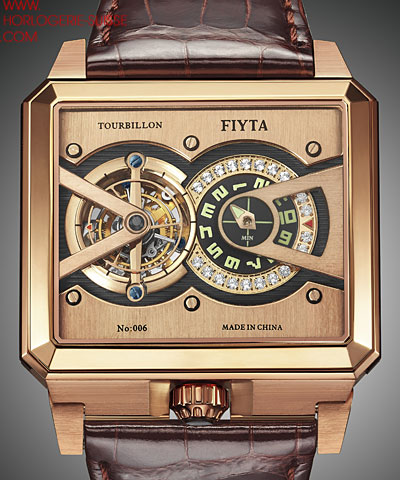

La page de Watch Around 
Chinese watchmaking’s upmarket ambitions
Par Jean-Luc Adam
Swiss watch brands are mesmerised by China. Its huge market and growth capture the imagination. But many also fear competition from what it can now produce. Visitors to Baselworld’s Hall 6 over recent years have noticed an outbreak of tourbillons and minor complications on Chinese-made watches of fine workmanship. Are Swiss watchmakers justified in dreading the emergence of competition in high-grade watches? A part of the answer must be found in the intentions and ambitions of the Chinese themselves.
 In an interview granted to Watch Around, Bruce Du, the managing director of the China’s most prominent watch brand, FIYTA, made the country’s ambitions clear. By 2015 China intends to produce increasingly high value watches and, in line with the 11th five-year plan, take its place among the great watchmaking countries.
In an interview granted to Watch Around, Bruce Du, the managing director of the China’s most prominent watch brand, FIYTA, made the country’s ambitions clear. By 2015 China intends to produce increasingly high value watches and, in line with the 11th five-year plan, take its place among the great watchmaking countries.
Never heard of FIYTA (pronounced fi-ya-ta)? For the past 20 years it has provided the official time of prime-time broadcasts on the China Central TV network. In 1995 it was elected “king of watch in China.” Most of all, FIYTA is the official timekeeper of China’s space programme. The brand’s popularity has soared since the triumphal return in 2008 of the Shenzhou 7 capsule from which Zhai Zhigang undertook China’s first spacewalk mission wearing a Spacemaster chronograph.
This recognition rests on genuine micro-mechanical skills. The watch manufacturer develops alone or in partnership, not only quartz movements but also selfwinding and tourbillon movements for their highgrade watches. Finally FIYTA has powerful backing as part of the empire of the China National Aero- Technology Import and Export Corporation (CATIC). We met Mr Du in the company’s Shenzhen headquarters in Guangdong province, not far from Hong Kong.
Your brand is young and virtually unknown in Europe. What’s its background?
It was in fact founded in 1987, but it goes back about 40 years. The founder, Men Tengshan, was a horological specialist and enthusiast. When the company was launched there were very few international brands in the Chinese market and that was our opportunity.
 Where did you get your watchmaking capabilities and technology?
Where did you get your watchmaking capabilities and technology?
Modern Chinese watchmaking has more than 50 years of experience and the resources to produce complex movements. FIYTA has brought together the best watchmakers and has additional training programmes for new recruits. We also work with movement manufacturers, who give us access to the technology for high-grade calibres.
Where would you position FIYTA in relation to a Swiss brand?
Somewhere in the mid-range, like Tissot, for example. However we do produce a few tourbillon watches, mainly for domestic customers who are keen on luxury products. We emphasise Chinese culture and history through specific designs more than our movements, which are quite conventional.
Do you think you can export that culture to the West?
We aim mainly at the Asian market – China, Hong Kong, Malaysia, Vietnam. Western markets are part of our future strategy, which is why we are at Baselworld, but Asia already constitutes a huge challenge for the brand.
The FIYTA style seems rather out of phase with Asian standards. Is it because tastes are changing or are your customers different?
Chinese customers are much younger than their European counterparts, and the men and women who wear a FIYTA watch are younger still – between 22 and 40 years old – quite wealthy and sensitive to fashion.
Doesn’t the same go for your domestic competitors, Ebor and Sea-Gull for example or Rossini, Beijing, Hangzhou, Shanghai and Guangdong? The first ones you mentioned have a very conservative style unlike ours. As for the others, they are in a lower bracket and are mainly producers and suppliers of movements. They are quite unlike FIYTA, which is a proper watchmaking brand, with its own designs and movements and with its own chain of outlets.
The ’Swiss made’ label seems to attract foreign watchmakers. Is it true that FIYTA has acquired a Geneva watch brand?
That’s right. Our holding company has just acquired the share capital of Montres Chouriet SA, a brand directed towards the Chinese market.
How will FIYTA watches benefit?
To date we don’t know whether we will take advantage of the resources or technical support from Switzerland. In any event, FIYTA is based on Chinese culture and we are confident of continuing our success story by focussing on quality and style. In a specialised industry like watchmaking, we cannot just offer better value for money to gain market share, as China has done in other sectors. The approach is much more complex. We have benefited from Switzerland’s long experience and tradition, but we have also drawn heavily from the Chinese watchmaking culture. I believe this combination is the key to our success with customers.
You have quite a lot of limited series in your collections…
That’s a Swiss speciality, and we are pioneers in this field among Chinese watchmakers. We’ll do even more limited series in the future, commemorating current or historical events in China. The possibilities are virtually endless.

Is the FIYTA watch company actually profitable, or is it more a showcase for the various activities of the CATIC conglomerate?
Our watches have driven the holding company on the Hong Kong and Shenzhen stockmarkets since 1993. When international brands started coming onto the Chinese market in 1996, FIYTA had to double its efforts, but it also benefited through its network of shops that now represent 70 Swiss brands. For the past five years production of FIYTA watches has increased 20% a year and we are about to reach 300,000 watches a year. Taking together our two businesses, watches and multibrand stores, we registered 40% growth in 2009.
Does that mean the more Swiss watches FIYTA sells, the more money it makes?
Absolutely! Representing Swiss watches also strengthens FIYTA’s culture. It enables us to develop our own style.
Your ladies’ watches are currently downsized men’s watches. Are Chinese women keen on chronographs and other complications, like their European counterparts?
Our 40 shops in the major cities also sense this trend coming. However, Chinese market trends are somewhat behind Europe, so we’ve got time to get ready.
© 
toute reproduction strictement interdite
Tweet
French version
Abonnez-vous à watch around